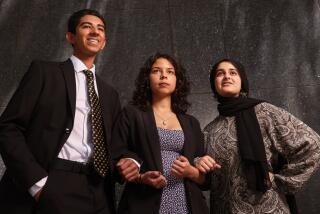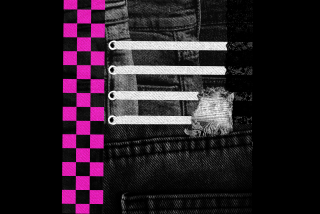Riots Raise Question of ‘Right’ Choices for Santa Ana Kids
“I would do it because, you know, everybody is doing it,” Kenya is saying. She is 14, with long dark hair that shimmers amber in the sun. When I mentioned the word looting , the ugly hooligan word, Kenya smiled. Maybe the word doesn’t sound that way to her. Kenya’s smile is shy and beautiful.
Kenya was talking to her friend, Manuel, who said that no way would he do it because the cops would get him and then he’d do time. Manuel is tall and lanky, 14 too.
But what if there were no cops?
“It would be tough,” he says, serious, thinking it through. “I know I would take something. Everybody does.”
We are in Santa Ana, outside Saddleback High School, when school’s just let out. There are lots of kids around, talking among themselves, waiting for rides from parents or friends. Many more are walking off on their own.
The kids have been talking a lot about what went down in Los Angeles. Video images have been stamped on their minds; they won’t forget them anytime soon. They’ve had guided discussions about it in class and the “Let’s sit down and talk about this” varieties at home.
If you line all these kids up and ask them, “Would you? Should you?” most of them would say that they should not. They say they know better than to take what is not theirs.
“Yeah, I know it’s wrong,” Kenya says. “But my mom’s not going to be there.”
Ryan walks up to listen in. He is 16, with a big loopy smile. “If it’s not going to hurt anybody else, I would do it,” he volunteers.
What about the owners of the ransacked stores, the burned-out jobs? You think you’d be hurt if you saw your life being carted off?
“I never really thought about that,” Kenya says, genuine wonder in her tone. “Oh, yeah,” she says. “Wow.” She sounds awe-struck by a discovery that she’s made.
Then more kids join the group. They are laden with books and binders, heavy with the suggestion that their homework will get done. Manuel’s got to run.
“It’s wrong!” Natalie says. She is practically shouting, her determination fierce. She is 16 years old. “Even if I was poor, I wouldn’t do that.”
“Those people are setting a bad image for all races,” Fanny, 17, adds. “It’s not about poverty. It’s about self-dignity.”
Kenya looks at her friends as she fiddles with her hair. “I mean, you guys, you see everybody else doing it. . . .” Her epiphany seems to have worn off.
“Would you jump off a bridge if you saw everybody else doing it?” Melissa cuts her off, incredulous, mad.
“Oh, I know it’s not right,” Kenya says, softly. Her smile is just a hint now. “But you see everybody else doing it.”
The refrain seems to mean something to Kenya, only her friends will not buy. They tell her, in so many ways, that she should be ashamed of herself. “How could she not get it?” they wonder. “Doesn’t she know?”
There’s a connection that Kenya’s friends are making that at first I do not understand. The more I listen, though, I realize that this childhood reality I’ve wandered into is more than just generations from my own.
This is not South-Central Los Angeles, not even in the symbolic sense that links such squalor with parts of Chicago’s South Side or Harlem in New York. Still, when you’re talking about “the right and wrong thing,” the choice is just as dangerously stark around here.
“My friend got killed two years ago,” Natalie says. “It was a set-up,” she says. By a gang.
“My cousin tried to get out of a gang, and he got killed,” Fanny says. That was a year ago. Fanny’s cousin, Phillip Gomez, was 18 years old.
You want more names of the dead? These kids can supply those too. When they talk of their neighborhoods, they identify them, simply, by the name of the reigning gang.
Natalie pulls out a satin Raiders jacket from her bag. She says it’s her dad’s and that she likes it, but she knows that she can’t wear it in the neighborhood. It’s one more symbol staked out by a gang.
“The veterans tell me to take it off,” Natalie says. The veterans are the older gang members. Natalie says they tell her to stay in school, that they get on her case about getting ahead.
“My veterans,” she says. “They care.”
Except the other ones, Natalie says, you want to stay away from them. She ticks off the names of the local gangs, the ones whose symbols are spray-painted around. She talks about what happens when you date one of them and about an “ex-friend,” a girl, who was just jumped in. That means that the other gang members beat her up.
“Sometimes you’ve got to forget the influence around you,” Fanny says. “It’s the individual, what’s inside you, that counts.”
“Yeah, when you tell the gangs no, you feel so good,” Natalie says.
“It’s just that, when you’re depressed, that’s when they get you,” Fanny adds.
“We are living in a war zone,” says Melissa, 17 years old. “It’s like a bomb, and we are all going to go down with it. . . . It gets you really upset. You’re living your life, minding your own business, and then there’s this everywhere you go.”
The this is the reality that these kids say they think about every day. It’s gangs and the mundane choices that lead that way. These kids are angry, and they are scared.
Kenya, is any of this getting through?
“Yeah, it changed my mind,” she says. “I don’t think it’s right.”
Yes, she said that before. Now she’s got to run.
More to Read
Sign up for Essential California
The most important California stories and recommendations in your inbox every morning.
You may occasionally receive promotional content from the Los Angeles Times.










